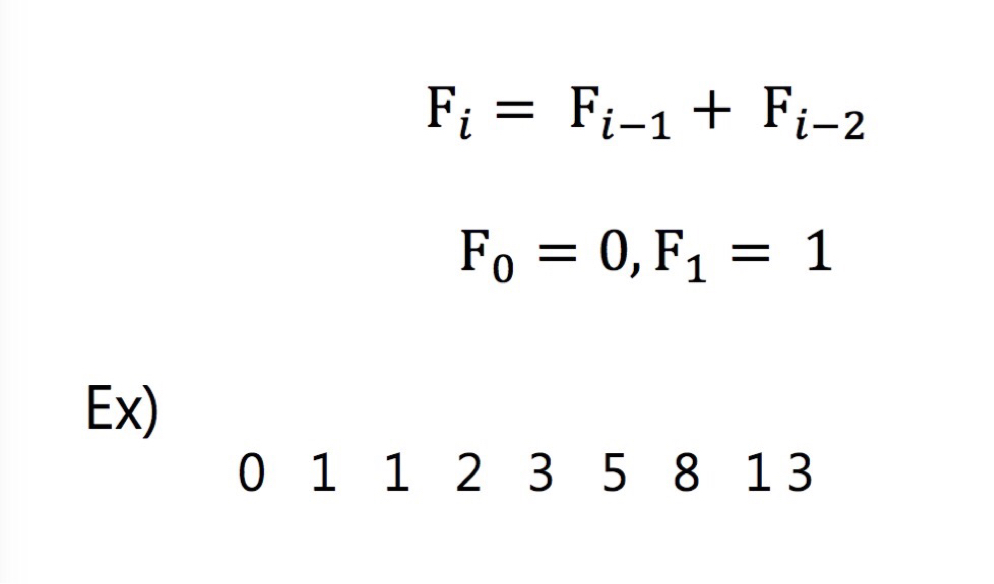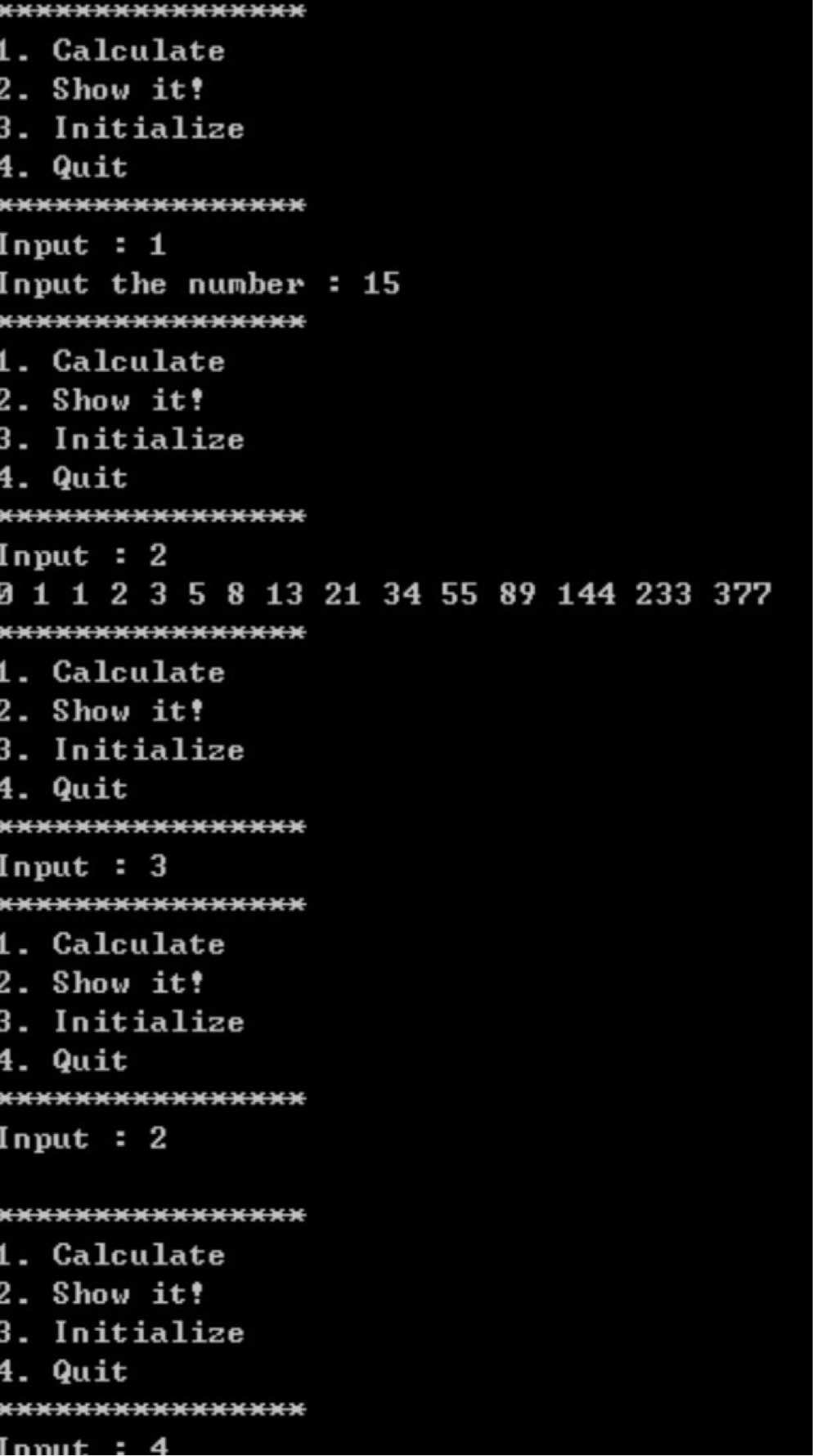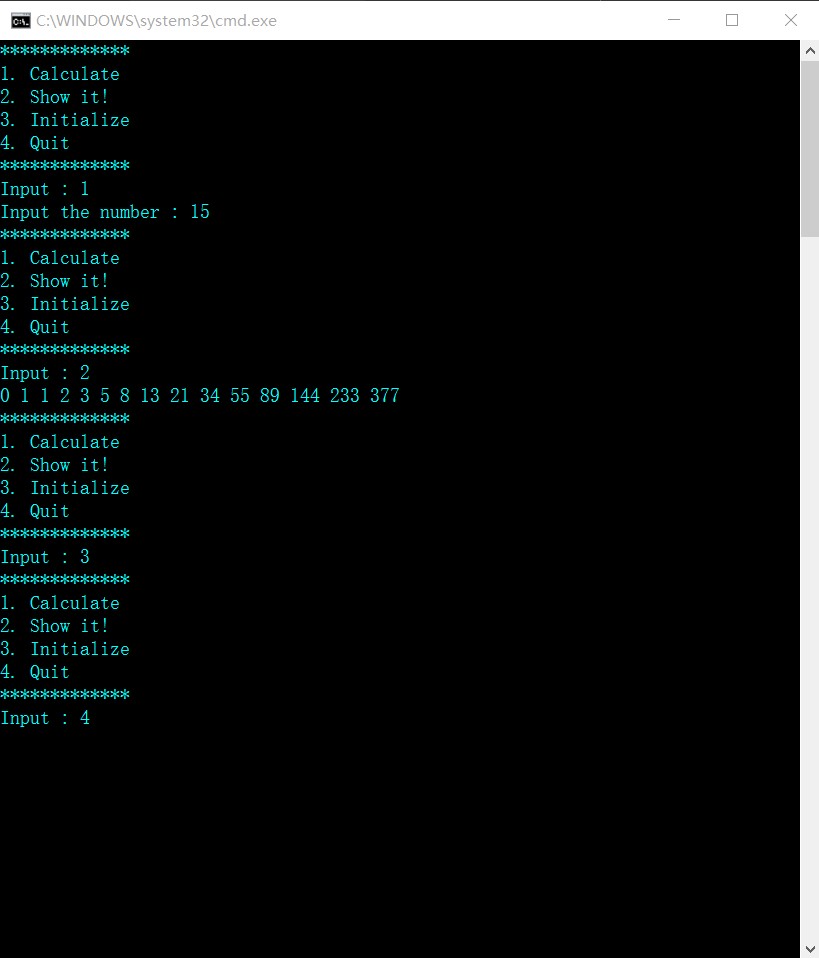c语言。
Write a program to calculate the Fibonacci sequence• The i-th element of the Fibonacci sequence is defined as follows.公式请看图 Ex)011235813
Fibonacci sequence• Input 1, input another numberto calculate the Fibonacci sequence• Input 2, show the Fibonacci sequence • Input 3, initialization• Input 4, terminate the program

void PrintMenu()
{
printf("*************\n");
printf("1. Calculate\n");
printf("2. Show it!\n");
printf("3. Initialize\n");
printf("4. Quit\n");
printf("*************\n");
printf("Input : ");
}
int main()
{
char a;
int b = 0;
int i;
int Fx = 1;
int Fxx = 0;
while(true)
{
PrintMenu();
a = getchar();
getchar();
switch(a)
{
case '1':
printf("Input the number : ");
scanf("%d",&b);
getchar();
break;
case '2':
for(i=0;i<b;i++)
{
if(i == 0)
printf("%d ",Fxx);
else if(i == 1)
printf("%d ",Fx);
else
{
printf("%d ",Fx+Fxx);
int temp = Fx;
Fx += Fxx;
Fxx = temp;
}
}
printf("\n");
Fx = 1;
Fxx = 0;
break;
case '3':
b = 0;
break;
case '4':
return 0;
}
}
return 0;
}
C语言中通过函数指针实现回调函数(Callback Function)
====== 首先使用typedef定义回调函数类型 ======
typedef void (*event_cb_t)(const struct event *evt, void *userdata);上面的语句表示event_cb_t类型函数范围值类型为void类......
答案就在这里:C语言中的回调函数
----------------------你好,人类,我是来自CSDN星球的问答机器人小C,以上是依据我对问题的理解给出的答案,如果解决了你的问题,望采纳。
#include<stdio.h>
void printList()
{
printf("*************\n");
printf("1. Calculate\n");
printf("2. Show it!\n");
printf("3. Initialize\n");
printf("4. Quit\n");
printf("*************\n");
printf("Input : ");
}
void nOfFab(int n)
{
int f1 = 0;
int f2 = 1;
int count = 2;
int tmp = 0;
if(n <= 0){
printf("\n");
return;
}
printf("0");
if(n == 1){
printf("\n");
return;
}
printf(" 1");
if(n == 2){
printf("\n");
return;
}
while(count < n){
tmp = f1;
f1 = f2;
f2 = f1 + tmp;
printf(" %d",f2);
count ++;
}
printf("\n");
}
void main()
{
int count = 0;
int select = 0;
int flag = 0;
while(!flag){
printList();
scanf("%d",&select);
switch(select){
case 1:
printf("Input the number : ");
scanf("%d",&count);
break;
case 2:
nOfFab(count);
break;
case 3:
count = 0;
break;
case 4:
flag = 1;
break;
}
}
}
我的代码比较简洁,求采纳!
#include<stdio.h>
int PrintMenu()
{
int a;
printf("*************\n");
printf("1. Calculate\n");
printf("2. Show it!\n");
printf("3. Initialize\n");
printf("4. Quit\n");
printf("*************\n");
printf("Input : ");
scanf("%d",&a);
return a;
}
int main(){
int n=0;
int i;
int f1,f2,list[300]={0};
while(1){
switch(PrintMenu())
{
case 1:
printf("Input the number : ");
scanf("%d",&n);
f1=f2=1;
for(i=1;i<=n;i++){
list[i]=f1;
f1+=f2;
list[++i]=f2;
f2+=f1;
}
break;
case 2:
for(i=0;i<n;i++)
printf("%d ",list[i]);
printf("\n");
break;
case 3:
n=0;
break;
case 4:
return 0;
}
}
}
